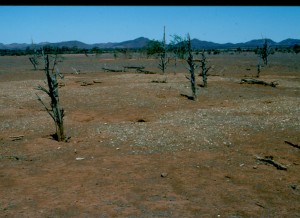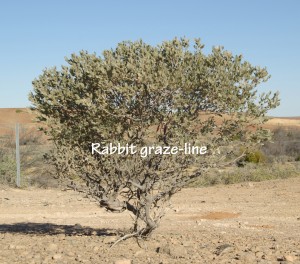In this section
Rabbit impacts on agriculture
There are several variables in determining the direct impact of rabbits on primary production, such as the distribution and density of rabbits, and the type, level and value of production. Livestock industries suffer most direct economic loss at present, but grain and horticultural crops, forestry and carbon plantings can all be affected.
It has been estimated that at the turn of the last century the direct cost of rabbits to Australia, due to lost beef, lamb and wool production and expenditure on control measures, was $206 million (Gong et al, 2009). Research has shown that as rabbit numbers increase pasture biomass decreases, species composition changes (e.g. there are fewer legumes and more grasses) and bare areas increase (Croft et al, 2002). Production (sheep liveweight and wool production) declines at higher rabbit densities (Fleming et al, 2002). It only takes 12-16 rabbits to consume as much feed as a grown sheep – about 16 rabbits/hectare is equivalent to one dry sheep (RABFS3, 2012). When in large numbers, rabbits can foul pastures.
Similar national evaluations are not available for horticultural and cereal crops, or for forestry.
Both reducing rabbit numbers and reducing control costs would improve the economics of primary production.
The indirect impacts of rabbits are harder to value, but just as real. Warren establishment and grazing by rabbits can lead to increased areas of bare ground and subsequent erosion by wind and water. On-farm that can mean lost production due to lost top-soil, damage to fences and waters and to increased weed problems. Rabbits preferential grazing of pasture species can also lead to increased weediness in paddocks.
On-farm erosion can also result in changes in water run-off and off-farm consequences to waterways through siltation and bank erosion, affecting water supplies and treatment costs as well as natural ecosystems. Similarly, wind erosion removes top-soil and dust poses risks to air quality and through deposition.
Useful references include:
- Croft JD, Fleming PJS & van de Ven R. (2002) ‘The impact of rabbits on a grazing system in eastern NSW. 1 – Ground cover and pastures.’ Australian Journal of Experimental Agriculture 42(7) 909 – 916
- Fleming PJS, Croft JD & Nicol HI. (2002) ‘The impact of rabbits on a grazing system in eastern NSW. 2 – Sheep production.’ Australian Journal of Experimental Agriculture 42(7) 917 – 923
- Gong W, Sinden J, Brasher M & Jones R. (2009) ‘ The economic impacts of vertebrate pests in Australia’ Invasive Animals Cooperative Research Centre, Canberra.
- RABFS3 (2012) ‘Economic and environmental impacts of rabbits in Australia. Rabbit Factsheet.’ Pestsmart.
Rabbit impacts on native vegetation
Rabbits are selective feeders and graze upon the most palatable plant species. Examples from shrublands include:
• Drooping sheoak (Allocasuarina verticillata). In a 1988 report Cooke concluded that, along the South Australian Coorong, natural regeneration of sheoaks had only occurred for a brief period after the introduction of myxomatosis. Based on trials after the release of rabbit haemorrhagic disease (RHD) Bird et al (2012) concluded that sheoaks were unlikely to regenerate in reserves when rabbits were present at, or above, densities of 0.5 rabbits / hectare. Their data indicated that ‘Allocasuarina seedling recruitment might be prevented by rabbits at densities so low that the presence of rabbits, let alone their effect on seedling survival, is barely noticeable to conservation managers’. They also noted that ‘existing biological control agents alone will not reduce rabbit numbers to the level where sheoak regeneration might occur’.
• Buloke (Allocasuarina luehmannii). After the release of RHD in 1966, rabbit numbers were reduced to very low levels in the Victorian Hattah-Kulkyne National Park and, for the first time in many decades, buloke seedlings regenerated, despite lower than average rainfall. However, the subsequent recovery of rabbit populations saw all but the largest of the seedling recruits killed by rabbit grazing at densities as low as 0.6 rabbits / hectare (Bird et al, 2012).
• Sweet bursaria (Bursaria spinosa). Trials and observations indicate that sweet bursaria is targeted by rabbits, but is better able to withstand grazing than are drooping sheoaks. In the Coorong it appears that the arrival of RHD alone was sufficient to permit some recruitment – even if only for a short time before rabbit populations began to increase (Cooke, 1988 & Bird et al, 2012).
• Golden wattle, Manna Gum & Drooping Sheoak. (Acacia pycnantha, Eucalyptus viminalis & Allocasuarina verticillata). Reforestation trials showed there was a non-linear, negative relationship between rabbit densities and both tree survival and above-ground biomass – even at very low rabbit densities, due to the selective (preferential) feeding of rabbits and limited recovery by trees. Young trees have a threshold foliage level, below which they will not recover from grazing. If trees can grow above the level to which rabbits graze their survival is much better but, the ‘escape height’ increases with rabbit density and non-fatal browsing may still restrict the tree by altering its form to be low-growing and multi-stemmed. Due to the substantial impact of rabbits (even at low densities) on palatable, browse intolerant species, it is recommended that revegetation be undertaken in areas from which rabbits are excluded (Forsyth et al, 2015).
Semi-arid and arid regions provide further insights about the impact of rabbits on vegetation. For many plant species it appears there have been two recruitment pulses – both due to the release of biological controls for rabbits; myxomatosis in 1951-2 and RHD in 1995-6. Some post-RHD plant recruits that are not yet big enough to escape rabbit grazing are now being lost, but it was noted by Mutze (2015) that following RHD:
- Highly palatable species prospered in areas without livestock, e.g. Allocasuarina luehmannii, Callitris gracilis, Eremophila alternifolia, Acacia ligulata, Acacia aneura and Alectryon oleifolius.
- Moderately palatable species were recruited in areas with livestock, but very few rabbits, e.g. Acacia victoriae, Ptilotus obovatus, Senna artemisioides, Acacia ligulata, Acacia kempeana, Acacia tetragonophylla, Rhagodia spinescens, Enchylaeana tomentose and Dodonea viscosa.
Palatable perennial shrubs were denuded in many semi-arid pastoral areas during early, historic, pastoral development – but destocking is not sufficient for their recovery if rabbits persist. As an example, a 390 hectare livestock exclusion was established at Koonamore, in South Australia’s pastoral zone, with little measurable recovery in fifty years. When rabbits were then eliminated, the subsequent twenty six years saw the recovery of many perennial species including Acacia aneura, Eremophila mitchellii and Maireana astrotricha (Sinclair, 2005).
Useful references include:
- Bird P, Mutze G, Peacock D & Jennings S. (2011) ‘Damage caused by low-density exotic herbivore populations: the impact of introduced European rabbits on marsupial herbivores and Allocasuarina and Bursaria seedling survival in Australian coastal shrubland.’ Biol Invasions 14:743-755
- Cooke BD. (1988) ‘The effects of rabbit grazing on regeneration of sheoaks, Allocasuarina verticillata, and saltwater ti-trees, Melaleuca halmaturorum, in the Coorong National Park, South Australia’. Aust. J. Ecol. 13:11-20.
- Forsyth DM, Scroggie MP, Arthur AD, Lindeman M, Ramsey DSL, McPhee SR, Bloomfield T, and Stuart IG. (2015) ‘Density-dependent effects of a widespread invasive herbivore on tree survival and biomass during reforestation’. Ecosphere 6(4):71. http://dx.doi.org/10.1890/ES14-00453.1
- Mutze G. (2015) ‘Barking up the wrong tree? Are livestock or rabbits the greater threat to rangeland biodiversity in southern Australia?’
- Sinclair R. (2005) ‘Long-term changes in vegetation, gradual and episodic, on the TGB Osborn Vegetation Reserve, Koonamore, South Australia (1926-2002).’ Aust. J. Bot. 53(4): 283-296.
Rabbit impacts on wildlife
Rabbits impact native wildlife through direct competition for feed or burrows, by changing the vegetation that sustains wildlife and protects the soil from erosion, and by maintaining high populations of predators.
Just as they compete with livestock for feed, rabbits also compete directly with native herbivores and, even at moderate population densities, supress species such as kangaroos and wombats. Rabbit control has been shown to be a critical component of wombat conservation efforts (Bird et al, 2012). The competitive impact is observable at times of high feed availability, as well as in harsher conditions.
Rabbits change the vegetation – e.g. their prevention of sheoak recruitment at all but very low population densities – and hence impact native fauna; such as the glossy black cockatoo (Calyptorhynchus lathami, nationally listed as a vulnerable species) which feeds heavily upon the seeds of sheoaks (Bird et al, 2012). The mere presence of rabbits threatens the survival of many Australian plants and animals.
Rabbits sustain higher populations of predators. As an example, rabbits have been the principal prey of dingoes in the Simpson Desert (Corbett & Newsome, 1987). Like rabbits, dingoes were introduced to Australia by humans – probably between 4-18,000 years ago – but the wild dogs have now ‘naturalised’ and are seen by many as part of the Australian environment. When rabbits are removed the diet of predators will include a greater percentage of native animals, but the reduced overall population of predators results in less actual predation on native species. Analysis also shows that long-term suppression of rabbits by control programs leads to reduced cat abundance, reduced predation of native fauna, and the recovery of threatened prey populations (Mutze, 2017). For these reasons, rabbit control is an integral part of programs to protect many endangered or vulnerable species.
The benefit of rabbit control for threatened species is highlighted by studies of the impact of RHDV which showed that in arid Australia, the dusky hopping-mouse (Notomys fuscus), the plains mouse (Pseudomys australis), and the crest-tailed mulgara (Dasycercus cristicauda) dramatically increased their range and abundance following suppression of rabbit populations by the virus. Fewer rabbits meant less competition for food and less predation from rabbit-dependent feral cats and foxes (Pedler et al, 2016).
Native predators, such as wedge tailed eagles (Aquila audax), also prey on rabbits, but do not appear to suffer following rabbit control programs. As rabbits decline, more kangaroos, reptiles and birds are eaten – partly due to their increased abundance following the decline of rabbits (Olsen et al, 2014).
Useful references include:
- Bird P, Mutze G, Peacock D & Jennings S. (2011) ‘Damage caused by low-density exotic herbivore populations: the impact of introduced European rabbits on marsupial herbivores and Allocasuarina and Bursaria seedling survival in Australian coastal shrubland.’ Biol Invasions 14:743-755
- Corbett LK & Newsome AE. (1987) ‘The feeding ecology of the dingo. Dietary relationships with widely fluctuating prey populations in arid Australia: an hypothesis of alternation of predation.’ Oecologia 74: 215-227.
- Mutze, G. (2017) ‘Continental-scale analysis of feral cat diet in Australia, prey-switching and the risk:benefit of rabbit control.‘ Journal of Biogeography. Vol 44, Issue 7.
- Olsen J, Cooke B, Trost S & Judge D. (2014) ‘Is wedge-tailed eagle, Aquila audax, survival and breeding success closely linked to the abundance of European rabbits, Oryctolagus cuniculus?’ Wildlife Research 41(2) 95-105 http://dx.doi.org/10.1071/WR14033
- Pedler RD, Brandle R, Read JL, Southgate R, Bird P & Moseby KE. (2016) ‘Rabbit bio-control and landscape scale recovery of threatened desert mammals.’ Conservation Biology. doi: 10.1111/cobi.12684


